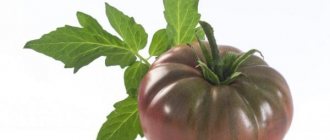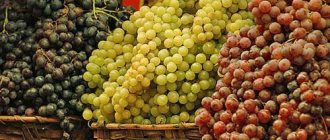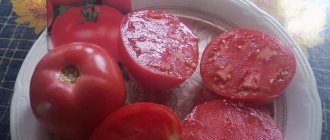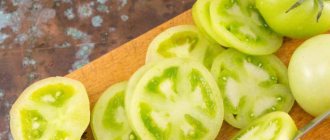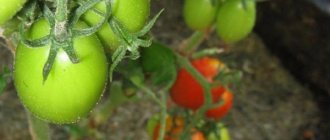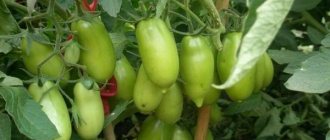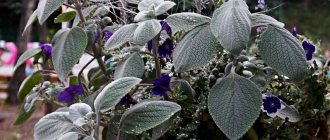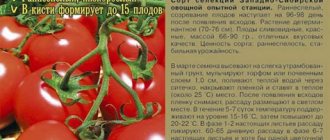Bred by whom?
The Kirzhach tomato thus belongs to the group of indeterminate varieties that require garter. These wonderful tomatoes, the fruits of which, judging by the reviews, are distinguished by simply excellent taste, were bred by specialists from the NP Research Institute of Indoor Vegetable Growing. This tomato was officially included in the State Register in 2003. The creators of this variety are E.V. Amcheslavskaya, S.F. Gavrish, V.V. Morev, O.A. Volok.
Bush formation
- All side branches must be removed from the stem. Since excessive density reduces air circulation, which can lead to damage to the plant by various fungal diseases, and high humidity will attract greenhouse pests - slugs, which can destroy the plant along with the fruits.
- As it grows, you need to remove the lower leaves and get rid of the stepsons. By withdrawing some of the nutrients, the stepsons interfere with the normal growth and development of the stem, which will inevitably lead to a decrease in yield.
It is better to remove excess leaves and pruning during the day, in sunny weather, then the cuttings will dry out faster.
- Pinching the top of the stem of “Kirzhach” is recommended to be done before mid-August so that the plant stops growing upward and can devote all its energy to the formation of fruits.
You can leave two stems, but in this case there is a high probability of a decrease in the weight of the fruit and a decrease in yield. Tomatoes of the hybrid variety “Kirzhach” continue to bear fruit until the end of September and are perfectly stored after harvesting, do not rot or spoil for at least two weeks. Judging by reviews from summer residents, tomatoes are resistant to mechanical damage that is possible during transportation of fruits.
general description
It is recommended to grow Kirzhach tomatoes in central Russia in film greenhouses. Unfortunately, this variety is not frost-resistant. At the same time, to cultivate tomatoes, a trellis should be installed next to the beds. In a greenhouse, such tomatoes usually grow up to 1.5 m during the season.
A special feature of this variety, among other things, is that the first inflorescence of these plants is formed above the 9-11th leaf. Next, brushes on the bushes are formed every three leaves.
The advantages of Kirzhach tomatoes, photos of which can be seen on the page, include the fact that they grow very strong and powerful. Externally, tomatoes of this variety look lush because they have good foliage.
Fruit characteristics
- Flat-round, smooth, fleshy tomatoes.
- Thick skin of rich red color.
- The average weight of each fruit is 150-250 grams.
- Inside, the fruits have from five to seven segments.
- When ripe, tomatoes do not tend to crack.
- The total yield from one bush, with favorable development, can exceed 6 kg of tomatoes.
Tomatoes of the “Kirzhach” variety have a traditional taste and aroma. Excellent for use in cooking and no less tasty in their natural form. The neat shape of the fruit and not so significant size make it possible to use tomatoes of this variety for pickling and pickling. And the juicy pulp of the fruit makes them an excellent ingredient for making ketchup and tomato paste.
See also
Description of the tomato variety Bread and Salt, its characteristics and yieldRead
Productivity
This variety is valued by summer residents primarily for the excellent taste of the fruit. The Kirzhach tomato has very good characteristics in terms of yield. Gardeners in a greenhouse often collect up to 6-6.5 kg of fruit from one such plant.
The undoubted advantage of Kirzhach, among other things, is that it is one of the earliest ripening indeterminate greenhouse varieties. The fruits of this tomato ripen already 110-115 days after planting.
The advantages of this tomato include the fact that its fruits ripen gradually. Therefore, summer residents have the opportunity to collect them until frost.
Description of the tomato variety Kirzhach with photo
Tomato Kirzhach is a first generation hybrid (F1), obtained in Russia by a team of breeders (Volok, Morev, Gavrish, Amcheslavskaya). It has a very high yield - up to 6.5 kg per bush and relatively large tomatoes. Can be grown in greenhouses, in the south also in open ground. Included in the register of selection achievements in 2002.
Main characteristics of the Kirzhach tomato variety:
- indeterminate (grows without restrictions throughout the season);
- medium height (120-150 cm);
- mid-ripening (fruits begin to form in 108-120 days).
The bush is powerful, with strong shoots, heavily leafy. The leaves are green, typical shape, medium size. The flowers are light yellow, united in inflorescences of a simple type, the first of them is higher than 9, 10 or 11 leaves, and all subsequent ones are formed every 3. There are several ovaries on the raceme, which produce 5-8 Kirzhach tomatoes.
Description of fruits
Kirzhach tomatoes are bright red, pink, round in shape with flattened top and bottom. The surface is smooth, with slight ribbing closer to the stalk. The skin is strong, so the fruits are not prone to cracking. On average, the weight of tomatoes is 130-150 g (according to the register), often they reach 180-200 g, and the maximum registered weight is 500 g.
Tomatoes reach 6-8 cm or more in diameter. The pulp is very fleshy, juicy, has no voids, and has a pleasant consistency. The taste is classic, with a balance of sour and sweet shades, the aroma is pronounced. 3-4 seed chambers are visible on the cut. At the same time, it is not advisable to collect seeds, since the Kirzhach tomato is a hybrid, not a variety: newly planted bushes will not bear fruit.
1 brush can produce up to 8 Kirzhach tomatoes
Description of fruits
Kirzhach tomatoes have a rich red color and a flat-round shape. The taste of these tomatoes is simply excellent - classic sweet and sour. Summer residents also praise the pleasant aroma of the fruits of this variety. The skin of Kirzhach tomatoes is very smooth, not too thick, but at the same time quite dense and durable.
The fruits of Kirzhach also grow quite large. The average weight of these tomatoes is 160-180 g. With good care, the bushes of these tomatoes can ripen fruits weighing up to 500 grams. Tomatoes set on bushes of this variety very well even under the most unfavorable weather conditions.
Advantages and disadvantages
- significant yield;
- prolonged fruiting 3.5-4 months (before the arrival of frost);
- resistance to a complex of infections;
- endurance to adverse factors;
- stress resistance;
- transportability and keeping quality;
- marketability and excellent taste;
- the skin does not crack.
Minuses:
- the importance of planting next to trellises;
- impossibility of self-harvesting seeds.
Reviews about tomato Kirzhach
Gardeners praise this variety not only for its excellent taste and high yield, but also for its versatility. Kirzhach is one of the few tomatoes that perfectly reveals its taste both fresh and canned. Judging by the reviews, salads made from the fruits of this variety are incredibly tasty. Thanks to their thick skin, these tomatoes do not crack during heat treatment during salting and pickling.
As many summer residents note, the advantage of this variety is, among other things, good transportability. The fruits of Kirzhach, judging by reviews, are stored for quite a long time. At room temperature, these tomatoes can remain ripe for up to two weeks.
Another undoubted advantage of the variety is resistance to diseases. Kirzhach tomatoes are very rarely infected with such common infections as tobacco mosaic, fusarium, and cladosporiosis. In addition, the stems of this tomato are durable and not prone to breaking off.
Features of the hybrid
The characteristics and description of the Kirzhach F1 variety are as follows:
- The first fruit harvest is obtained 110 days after the development of seedlings.
- The stem of the plant grows up to 140-150 cm. The bush is not prone to damage due to the presence of a large number of berries on the branches.
- Many large leaves are formed on the stem. The root forms many adventitious branches, and this helps the hybrid absorb the necessary substances faster.
- Each ovary produces up to 5 berries.
- The fruits have a spherical shape. They are covered with a dense skin, colored red.
- The weight of the berries ranges from 0.15 to 0.25 kg. Inside they contain 5-7 seed chambers.
Reviews from farmers growing this hybrid show that its yield is 6 kg of berries per bush.
Transportation of fruits is possible over long distances, since the skin prevents the berries from cracking due to mechanical damage. Tomatoes are stored in a cold place for 15 days.
The hybrid is bred throughout Russia. In the North Caucasus and Volga region, this variety grows in open areas. In the middle zone, tomatoes are grown in film greenhouses without heating. In the northern regions of the country, it is recommended to grow tomatoes in greenhouse blocks and greenhouses.
Tomatoes of the “Kirzhach” F1 variety are characterized by high yield. The ovaries on the bushes are formed well, short and sessile inflorescences produce, on average, five fruits. “Kirzhach” begins to bear fruit approximately 110 days after germination.
Description of the plant:
- a strong stem that is not prone to breaking and can withstand the weight of a large number of fruits;
- abundant large and not too dissected foliage;
- the stem grows up to one and a half meters in height or more;
- has a closed habit, which protects the fruits from sunburn;
- The main root is well developed, and during growth many adventitious roots are formed, which helps the large plant receive nutrients.
Hybrid "Kirzhach" has increased immunity to fusarium, tobacco mosaic virus, cladosporiosis, and its fruits are not affected by blossom end rot.
Features of cultivation
Judging by the description of the Kirzhach tomatoes from the manufacturer, this variety was bred specifically for growing in a greenhouse. But, of course, in central Russia it is not worth planting these tomatoes immediately in a permanent place, even under a film. This variety is cultivated in our country, like any other, using the seedling method.
The seeds of these tomatoes are sown in March. It is best to plant Kirzhach tomatoes directly into cups. In this case, they will not have to be dived. If planting material of this variety was purchased from a trusted supplier, for example, it is not necessary to treat them with potassium permanganate and growth stimulants before planting.
Tomatoes of this variety are usually transferred to a permanent place in early May. The soil in the greenhouse is first improved using sand and humus or peat. Kirzhach tomatoes should be planted on ridges, since their bushes grow quite large and fluffy, so that there are 2-2.5 plants per 1 m2. In this case, experienced summer residents recommend pre-spilling the holes for tomatoes with hot water and a solution of potassium permanganate.
Supports for these tomatoes in the greenhouse should, of course, be installed in advance. Seedlings are tied to trellises immediately after planting. In the future, it is recommended to form Kirzhach tomatoes using the “one stem” method.
Key features of post-disembarkation care
Planting in greenhouses is usually done at the end of May. It is important that the earth has time to warm up. For 1 sq. It is recommended to plant no more than four bushes per meter; the ideal planting pattern for the “Kirzhach” variety is 40 x 60 cm.
The characteristics of the variety indicate the unpretentiousness of the plant. Tomato variety "Kirzhach" does not require special care. The main thing is to ensure regular watering, preferably at the root. It is important to ensure that the water does not dislodge the soil around the stem. It is also necessary to loosen the soil and weed out weeds from time to time.
See also
Characteristics and description of the Roma tomato variety, its yieldRead
To obtain a high yield, the plant must be formed into one stem. A tall, lonely stem under the weight of fruit will need additional support, so a few days after planting the bushes need to be tied up.
How to water correctly?
The Kirzhach tomato variety, like almost any other variety, should not be moistened too often, but generously. It is recommended to water these tomatoes carefully, trying to ensure that their green mass does not get wet. The greens of these tomatoes are dense. Therefore, excessive moisture can lead to the development of late blight and rot in plants. To avoid such a problem, it is advisable to ventilate the greenhouse itself where Kirzhach is grown from time to time.
After each watering, the earthen crust under these plants must be removed. This will make air exchange in the area of tomato roots more intense. As a result, the plants will develop much better. In addition, removing the peel under such tomatoes protects them from the development of late blight and rot. Simultaneously with loosening after watering, Kirzhach tomatoes are usually weeded.
Reviews
Elena. Only those who have not tried to grow their plants are indifferent to the products of the Gavrish company. I first bought Kirzhach tomato seeds back in 2004, and I’m still planting them. This is the best option for a greenhouse; maintenance is minimal, and the result is always excellent. Weak seedlings take a long time to gain weight, the most unsuccessful bushes can be spudded, they will quickly produce lateral roots, grow and catch up with stronger plants. I form a hybrid into 2 stems and remove a significant part of the leaves so that the bushes are well ventilated.
Tatiana. I live in the Astrakhan region, Kirzhach grows in the open air. Difficulties often arise during the hottest periods. The bushes are very leafy, even when formed into 1 stem, you always want to thin out the leaves, but you can’t, otherwise the tomatoes will get baked in the sun. I tried to build special canopies with mesh for shading, but such structures interfere with fruit collection and care. We recently installed a heated greenhouse for a winter garden, I’ll try to grow Kirzhach there.
How do they fertilize?
For the first time, fertilizing for these tomatoes is applied to the soil when planting seedlings. A little ash and well-rotted manure are added to each hole under the plant. The next time Kirzhach tomatoes are fertilized three weeks after planting. In this case, mineral fertilizers containing phosphorus and calcium are usually used as fertilizing. Nitrogen compounds, as well as manure and humus, are not recommended to be used at this time to improve the soil under plants. Otherwise, the tomatoes will grow too much green mass. And this will happen to the detriment of the ovaries.
Features of agricultural technology
Sowing Kirzhach tomato seeds must be done a couple of months before the expected date of planting the seedlings in a greenhouse. The estimated sowing time is February or March, depending on the region of cultivation.
Note! If the seeds are sown earlier, they will sprout and grow quite well. But the yield will be much lower.
Before planting seeds, you need to prepare containers with soil. The soil should be lush, with the addition of peat and river sand.
The first picking is carried out after the appearance of two true leaves. However, experienced gardeners advise re-picking after a small tomato has noticeably stretched out. This procedure is necessary to strengthen the root system of the plant.
Kirzhach tomato fruits
The plant needs to be fed 14 days after the first picking. During this period, mineral mixtures are used as fertilizing. Without timely feeding, the plant may become sick, which will lead to further deformation of the fruit.
Note! A week before the intended planting, it is necessary to begin hardening the seedlings.
Sowing this tomato seeds directly into the ground is not effective. It is grown only by seedlings with the planting of young seedlings (50-60 days old) in a greenhouse structure.
Advice. For 1 sq.m. It is recommended to plant 4 tomatoes.
Further care for tomatoes in a greenhouse is usual - weeding, loosening the soil, watering, and fertilizing. The formation of a bush is carried out in 1 stem. Pruning and removal of some foliage are required.
Reviews from gardeners about tomato are good:
- Lyudmila from Novosibirsk writes that she has been planting this hybrid for several years now. Her bushes are usually simply hung with tomatoes. The fruits themselves are large, dense, have good taste and are perfectly stored.
- Irina from Latvia reports that she planted one bush of such a tomato for testing, and it turned out to be the only one that did not get late blight.
- Nadezhda from Bokhan planted this variety for the first time and was pleased with her choice. The tomatoes were large, beautiful, tasty, and stored for a long time.
- Alla from Belarus also highly appreciated Kirzhach. Her plants did not get sick until the end of the season. The tomatoes stayed well on the bushes and were large and dense.
- Nikolai Svetlov from Belgorod considers the tomato quite successful. He was especially impressed by the weight of the fruits, which weighed up to 300 g.
We invite you to familiarize yourself with: Tomato Masha and the Bear
The hybrid variety Kirzhach is a reliable tomato that will not let you down even in unfavorable conditions. And it is popular among gardeners for its strong immunity, its high yield when placed in small areas, taste characteristics, and excellent appearance.
Helpful advice
Experienced summer residents advise picking some of the Kirzhach tomatoes from the bush while unripe. Such fruits will reach ripeness indoors quite quickly. At the same time, removing some of the tomatoes from the bush will stimulate the formation of new ovaries. That is, this method allows you to slightly increase the yield of Kirzhach.
Also, experienced summer residents advise beginners to inspect the bushes of this variety from time to time to identify deformed ovaries. It is recommended to pinch such brushes immediately. This will also help increase the yield of tomatoes.
Growing and care
The bushes are transplanted into the greenhouse if there are 7-8 leaves. The holes are placed at a distance of 45 cm. Add 1 tbsp to each hole. wood ash and superphosphate. A week later, the first garter is performed.
Fertilizer is applied 3 weeks after planting on the site. Before flowering, preference is given to nitrogen-containing products (nitroammophosphate, bioinfusions, mullein). During flowering and ripening, root feeding is carried out:
For irrigation, boric acid and whey solution are used. Watering is carried out moderately, with a frequency of 1 time every 3-4 days. Use settled water. The best time is evening hours.
What do you need to know?
Thus, we found out what the Kirzhach tomato is (reviews, photos, yield). Growing these tomatoes in your garden is not too difficult. However, Kirzhach tomatoes have one feature that gardeners should know about. This variety belongs to the first generation F1 hybrids. Therefore, you should not remove seeds from the fruits of this variety for planting next season. In any case, tomatoes grown from such material will not have the excellent qualities of Kirzhach. Those summer residents who like it will have to purchase the seeds of this tomato for planting again every year.
Description and characteristics of the variety
Tomato Kirzhach F1 appeared thanks to the work of domestic breeders. In all respects it suits farmers.
Tomato diseases
As already mentioned, Kirzhach is resistant to many tomato diseases. However, summer residents can still encounter various kinds of infections and fungi when growing these tomatoes in a greenhouse. The main threat to these tomatoes, like most others, is late blight and rot.
In order to prevent the development of such diseases, it is recommended to spray Kirzhach tomatoes with some fungicide for preventive purposes a couple of weeks after planting the seedlings. This could be, for example, Bordeaux mixture or simply a solution of copper sulfate.
How to grow "Kirzhach"
- It is recommended to sow two months before the plants are supposed to be planted in the greenhouse. Approximately from the end of February to the beginning of March. If you sow tomatoes of the “Kirzhach” variety earlier, the sprouts will sprout together and grow well, but the yield will decrease.
- In containers for germination, you need to prepare soil that is loose and nutritious, with the addition of peat and sand.
- The first time picking is done, as expected, after the appearance of real leaves. But reviews from experienced gardeners indicate the need for repeated picking. It should be carried out after the tomato sprouts have noticeably elongated. This is done to form a powerful plant root system.
- Feeding is carried out two weeks after the first picking. To do this, you can use a solution of mineral mixtures.
Without feeding, plants may experience a lack of nutrients, which will negatively affect the development and quality of the fruit.
- Before planting, seedlings must undergo a hardening course. You can walk the sprouts on the balcony or in the greenhouse for several hours. On warm sunny days, you can extend the “walk” time, but be sure to bring it into the house at night so that the young plants do not die from the cold.
Rules of care
To grow tomatoes of the Kirzhach F1 variety, the seedling method is used. Depending on the climatic characteristics of the region, seeds are planted in late February-early March.
Important! Before planting tomato seeds, it is recommended to treat them with a growth stimulator and an aqueous solution of potassium permanganate.
Seeds of the Kirzhach variety from trusted producers usually do not require pre-treatment (information is indicated on the packages).
Germination stages
- Loose and nutritious soil is prepared in the boxes (with the addition of sand and peat). You can also add wood ash or superphosphate to the soil.
- Tomato seeds of the Kirzhach F1 variety are laid out on a moistened soil surface in even rows and sprinkled with a thin layer of earth (approximately 4-6 mm). The soil surface is sprayed with water. To prevent the soil from drying out, the box is covered with plastic film or glass.
- It is recommended to place the container in a warm place (approximately 20-23˚ C). As soon as the first tomato sprouts appear, the film is removed and the boxes are placed in a lighted place. Containers should be placed in a warm, well-lit place, without drafts.
- When the second pair of leaves appears on the tomato sprouts of the Kirzhach variety, it is necessary to fertilize. As a fertilizer, you can use a solution of a mixture of phosphorus, nitrogen, and potassium, taken in equal parts. After a few days, you can plant Kirzhach tomato seedlings in separate pots. The sprouts must be picked up carefully so as not to damage the tomatoes.
On the eve of planting Kirzhach seedlings in the greenhouse, it is necessary to harden the seedlings. To do this, two weeks earlier the tomatoes are taken out into the open air. Of course, you shouldn't get carried away. Only on warm sunny days can the Kirzhach F1 tomato variety stand outside for several hours. This procedure is especially important when planting seedlings in an unheated greenhouse.
It is advisable to start planting tomato seedlings in early May. To create favorable conditions in the greenhouse, it is advisable to annually update the top layer of soil. To do this, clean river sand and humus are poured into the garden soil.
The holes are dug at a distance of 35-45 cm from each other. Wood ash or a tablespoon of superphosphate is added to each hole.
After transplantation, each seedling of the tomato variety Kirzhach F1 is tied to a support (stakes, rods or trellis). Since the tomato grows very quickly, high supports are immediately installed. Form a tomato into one stem, carefully removing unnecessary shoots. After three weeks, you can fertilize the tomatoes. Solutions of mineral mixtures (mainly phosphorus and potassium) are used as fertilizers. During this period, it is recommended to abandon the use of nitrogen fertilizing, as it promotes abundant growth of tomato greens, which prevents the formation of ovaries.
Watering tomatoes
The Kirzhach variety does not welcome abundant watering. For these tomatoes, it is preferable to choose moderate soil moisture twice a week. But this regime depends on climatic conditions. In dry, hot summers, Kirzhach tomatoes need to be watered more often. It is recommended to pour water at the root.
Advice! After watering, it is advisable to ventilate the greenhouse. This measure will prevent the possible appearance of gray rot or black leg on Kirzhach tomatoes.
It is imperative to regularly loosen the soil to remove the crust that impedes air exchange.
To provoke the appearance of new ovaries, you can pick Kirzhach tomatoes unripe. It is advisable to monitor the formation of deformed ovaries and immediately tear them off.
Tomato
Tomato Kirzhach is a hybrid of Russian origin, the author is the agricultural company Gavrish. It was included in the State Register in 2002. The main advantage is the excellent fruit set in closed ground; under such conditions, the hybrid can be grown in all regions of Russia.
Planting in open ground is only permissible in areas with a warm climate. Let's get acquainted with the characteristics of the Kirzhach tomato and highlight the features of cultivation.
Description of tomato Kirzhach
The hybrid is included in the State Register in the third light zone of the Russian Federation, however, numerous experiments by gardeners have shown that the list of areas can be significantly expanded. Kirzhach is an indeterminate tomato with an average ripening period; the fruits ripen 105–115 days after germination. This tomato is approved for cultivation using a new, low-volume technology.
Characteristics of the bush and fruits
The plant is taller than one and a half meters with an average number of branches, strong, not prone to breaking off, the branches can withstand the weight of the fruit well. There are many leaves, they are large, slightly dissected. The first inflorescence is formed after the 9th leaf, subsequent brushes are formed every 3 leaves. One tassel contains 3 to 5 tomatoes.
The tomatoes are fleshy, flat-round, uniformly rich red in color, weighing from 130 to 250 grams. The skin is smooth, elastic, and when fully ripe the tomato does not crack. The pulp is dense, of a pleasant consistency, slightly sugary, the taste is very good, slightly sour and sweet. There are from 4 to 7 seed chambers, they are small, there is not much liquid.
Yield and use
With proper agricultural technology, up to 32 kilograms of tomatoes are harvested per square meter (more than 6 kilograms per bush), the number of marketable fruits reaches 99%. There are practically no small, inconspicuous specimens; Kirzhach can be grown for sale. The hybrid gives the best results indoors. Productivity is stable.
The Kirzhach tomato has a traditional taste, so it is suitable for fresh consumption and various culinary processing. The taste is not lost when frozen. The hybrid is not used for drying.
Thanks to the neat shape and not too large size of the fruits, they can be taken for whole-fruit canning, pickling or pickling. Juices, ketchups or pastes are thick and very aromatic.
The tomatoes are dense, they tolerate transportation well, and can be stored in the refrigerator for up to 2 weeks.
Resistance to adverse factors and diseases
Kirzhach has excellent immunity to blossom end rot, tobacco mosaic virus, cladosporiosis and fusarium.
It turns out that the hybrid is not afraid of the most serious problems of culture, and it is also rarely affected by pests.
The variety is recommended for growing in greenhouses; it does not tolerate cold weather and does not like heat. When grown in open ground (in the south), the bushes need to be shaded in particularly hot weather.
Advantages and disadvantages
The technology for cultivating tomatoes hydroponically appeared not so long ago. Kirzhach is one of the few varieties and hybrids suitable for such conditions.
The innovation is still only available to a few; most gardeners grow tomatoes in the usual way.
Therefore, we will talk about the main pros and cons of the hybrid, which usually influence the choice, without delving into the features of low-volume cultivation technology.
Positive traits
- extended fruiting period, tomatoes set well before the first autumn frosts;
- resistance to the most dangerous diseases and crop pests;
- high productivity in small areas, neat bush habit and fertility of the variety allow you to save space;
- high commercial quality of tomatoes, transportability, keeping quality;
- good taste, versatility.
Negative qualities
- difficulties when growing in open ground (weak resistance to heat and low temperatures);
- the need for constant care - pinching, tying and removing leaves.
Those who have already tried to grow Kirzhach and appreciated all its advantages are unlikely to refuse such a tomato, it is very good! However, it is worth remembering that this is a hybrid tomato; seeds cannot be collected from it for subsequent sowing.
Features of planting and care
Seedlings begin to be prepared from the end of February to the first days of March, picking is carried out when the first true leaf appears.
During the period of growing seedlings, one should not forget about watering, fertilizing and organizing additional lighting.
Elongated and weak Kirzhach tomato seedlings do not tolerate transplantation well, they slow down in growth and take a long time to gain strength. At the time of planting (late April), the bushes should be about 50–55 days old.
The optimal planting scheme is 40x60 cm; the Kirzhach tomato is watered and fertilized, like any other varieties. Supports for the garter are installed immediately upon planting. Strong seedlings develop very rapidly during the first 2 or 3 weeks. In open ground, the leaves are removed from the lower part of the bush, the upper ones protect the fruits from sunburn, and in the greenhouse you can thin out the crown.
It is advisable to form a Kirzhach tomato into one stem; the remaining stepsons are removed. If you leave them, the bush creates too dense thickets, the tomatoes become smaller due to lack of nutrition, and set worse.
Towards the end of the growing season, you need to look at the long-term weather forecast and pinch the top 2-3 weeks before the onset of frost.
Thus, all the plant’s strength will be spent on the formation and ripening of fruits, and not on increasing green mass.
The Kirzhach tomato can be called an ordinary representative of the crop; it has fruits of typical color, taste, aroma and shape. The popularity of the hybrid is due to its productivity, comparative unpretentiousness and special resistance to disease. Be sure to try this tomato, it will not disappoint you.
Disease prevention and pest control
Despite the high immunity of the Kirzhach variety, greenhouse tomatoes require preventive measures.
To avoid diseases, you need to control the humidity level in the greenhouse and monitor air circulation. To do this, the greenhouse is regularly ventilated, and the leaves on the bushes are thinned out. It is recommended to dust the soil with wood ash and water the bushes with a manganese solution.
Large fruits are often attacked by insects. Pests include Colorado potato beetles, slugs, aphids, and whiteflies. Bushes should be inspected frequently and insects should be removed at the first sign of invasion: collect slugs, beetles and caterpillars, wash off aphids with soapy water, hang sticky tapes to catch whiteflies.
Pests can be controlled using traditional methods (treated with solutions of pepper, ash, mustard, garlic, wormwood), biological products (Metarizin, Entocide) or insecticides (Confidor, Enzhio).
Growing rules
Depending on the climatic conditions of the region, Kirzhach tomatoes are grown in open or closed ground. To properly grow a crop, you need to carry out a number of agricultural activities. These include: planting seedlings, replanting tomatoes, and subsequent care.
Large and juicy tomatoes - Monomakh Cap tomato: reviews on yield, description of the variety
Planting seedlings
The best time to sow tomato seeds is at the end of February, beginning of March. Approximately 2 months before transplanting seedlings. First of all, loose, nutritious soil is prepared in a container and mixed with peat and sand.
Shallow grooves are made on the surface of the soil with a distance between them of 5-7 cm. The grooves are watered with warm water, after which the seeds are laid out at a distance of 15-20 mm. The sowing is covered with soil, carefully watered and covered with film.
The container must be placed in a lighted place, and a stand must be installed to allow air access to the root system. During the growing period, the sprouts are watered and processed.
According to reviews from experienced gardeners, picking Kirzhach tomato seedlings is carried out in two stages. After the first leaves appear and after the sprouts noticeably stretch out. This treatment stimulates root branching.
Tomato transplant
With good care of the seedlings, after 50–55 days the young seedlings form the desired structure and are ready for transplanting. This period falls at the end of April and continues until the end of May.
If planting is planned in open ground, then within a few weeks the seedlings are taken out into the open air for a couple of hours. It is better to choose warm weather. With this procedure, the sprouts gradually get used to temperature changes.
When the soil has warmed up, seedlings are planted per 1 square meter. m. up to 4 bushes, with a planting pattern of 40 x 60 cm. In the case of planting in greenhouse conditions, the soil is first prepared by adding river sand and humus to the soil. In both cases, the stem is immediately tied to a support, since in the first weeks the seedlings rapidly develop and stretch upward.
Subsequent care for tomatoes
Descriptions and reviews from experienced summer residents on caring for Kirzhach tomatoes recommend treating the stem, feeding the plant, mulching and watering in a timely manner.
For this variety, it is effective to remove the shoots, which forms one strong stem. In open ground, the leaves in the lower part of the bush are removed, and the upper ones are left for protection from sunlight. In the case of closed ground, it is necessary to thin out the crown. Until mid-August, the tops are pinched so that the plant reduces its growth and also devotes its energy to the formation of juicy tomatoes.
After the seedlings have adapted to soil conditions, after 3 weeks you can use fertilizing in the form of solutions of mineral salts of phosphorus or potassium. It is recommended to mulch the soil during this period. To do this, one of the materials is poured onto the top soil - sawdust, shavings, crushed bark. This will help protect the surface from drying out, as well as from weeds.
Water the plant twice a week. If the summer is hot and dry, then watering is repeated as needed. Periodically it is necessary to loosen the soil, which provides air to the roots.
Early ripe tomatoes
Early ripening is the main indicator when choosing a variety. In unstable climates, extra-early and ultra-early tomatoes are popular. Such tomatoes should tolerate return frosts well. Have time to ripen during the short summer in the Far Eastern regions. Ripening is considered early if the yield of the crop begins in less than 100 days from germination.
Open areas
Depending on the cultivation conditions, breeders offer the following varieties for unprotected beds:
| For open ground | |||
| Name | Ripening time, days | Peculiarities | Characteristic |
| Benito | 70-75 | Ultra early determinant hybrid | Compact bushes up to 50 cm. Weight 120-140 g. Shape like cream Red fleshy |
| Alpha | 87-96 | Determinate variety | Up to 45-50 cm in height. Weight 50-60 g. Red, round |
| Don Juan | 90-100 | Determinant variety | Does not exceed 70 cm. Average weight 70-80 g. Pros - transportability, keeping quality |
| Gina | 90-100 | Determinant variety | Within 60-70 cm height of bushes Weight from 190 to 350 g. Fruits are fleshy, orange-red |
| Cupid | 85-90 | Hybrid determinants | Height at 60 cm. The fruits weigh 70-100 g. Flat-round shape Designed for pickling, commercial production |
| Sanka | 85-96 | Ultra-early ripening determinant variety | Bushes about 35-40 cm. Tomatoes 85-100 g. |
| Legionary | 90-95 | Hybrid determinants | Spreading low bushes up to 60 cm. Pink tomatoes weighing 140-150 g. Resistance to late blight |
| Marisha | 85-90 | Determinant variety | Low bushes up to 40-50 cm. Weight from 50 to 120 g. Round, red |
In greenhouses and open areas
There are universal varieties that are suitable for cultivation in greenhouse conditions and in open beds. These include:
- Rajah. Early ripening semi-determinant. Ripens in 88-95 days. The length of the branches is about one meter. The shape is elongated, weight is 250-280 g, the flesh is fleshy and sugary;
- Abundant F1. Low-growing hybrid of determinants. The color is pink, the taste is tomato with a predominance of sweetness over sourness. Weight 80 g;
- First grader. Low-growing determinant. Shoots do not exceed 1 meter. The average weight is in the range of 140-280 g. The color is red, the shape is round. There is light ribbing. Watermelon pulp is sugary. The skin is durable. For maximum productivity they lead into three trunks;
- My love. Ripening begins in 85-95 days and occurs simultaneously. The fruits are large in size, weighing more than 250 grams. The color is bright red, the skin is glossy, not cracking. The taste is dominated by sweet notes. Resistance to late blight;
- Skorospelka. An unpretentious variety with spherical fruits. The harvest is harvested after 85-87 days. The color is red, the taste is bright and memorable.
For greenhouse plantings
| For greenhouses | |||
| Name | Ripening time, days | Peculiarities | Characteristic |
| Greenhouse precocious | 80-90 | Hybrid determinant ultra-early ripening | Height up to 0.7 m. Fruits 100-170 g, red, round |
| Superstar | 85-90 | Semi-determinant variety, ultra-early ripening, large-fruited | Height within 1-1.4 m. Weight 200-300 g, flat-round shape, sweetness |
| Gift | 90-100 | Hybrid of semi-determinants of early maturation | Bushes 0.6-0.7 m. Tomatoes 130-180 g. Keeping quality Do not crack |
| Mandarin duck | 90-100 | Indeterminate variety tall-growing carpal | The fruits are bright orange, weight 80-110 g. Tolerates cold weather and drought perfectly. |
| Sugar raspberry plum | 87-95 | Semi-determinate variety | The height of the bushes is within 1-1.4 m. Crumb fruits 20-25 g each. They are stored for a long time and tolerate transportation well. |
| meal | 85-95 | Indeterminate variety | Shoots up to 1.8 m high. Tomato weight up to 20 g. Red color, elongated shape Bonuses: stress resistance and drought resistance |
| Poznan | 95-100 | Indeterminate variety | Shoot length 2 m, require pinching Weight about 100 g. Orange color, round shape |
| golden brush | 95-98 | Indeterminate variety | Height 1.5 m. Tomatoes 20-25 g. Pear shape |
In the apartment and home garden
Compact, early-ripening tomatoes are effectively grown on loggias, balconies, verandas and window sills. These are the following varieties:
- Pinocchio. Low-growing indoor variety. Height 20-30 cm. Tomatoes weigh 15-20 g;
- Minibel. Ripens in 88-95 days. Compact bushes reach 40 cm and do not require pinching or pinching. Average weight 15-25 g;
- Room surprise. Ripening in 80-90 days. Height up to 50 cm. Weight 50-60 g. Plum-shaped shape, red color;
- Indoor pygmy. Determinant variety. The harvest ripens in 80-87 days. Shoots up to 25-30 cm. Tomato weight 20-25 g. Fruits are red, round.
Tomato pests and diseases
Kirzhach is characterized by increased resistance to many diseases. However, in greenhouse conditions there is a possibility of the appearance of some diseases.
Late blight (fungal disease) is one of the most common diseases of tomatoes. High humidity in the greenhouse and cool temperature can provoke the appearance of fungus. The disease affects tomatoes, leaves, and stems. Symptoms appear as brown spots.
Krill oil is a valuable product for human health. Which is better krill oil or fish oil? Benefits, harms, contraindications
The complexity of the situation lies in the fact that it is no longer possible to completely cure the plant. Alternatively, you can contain or slow down the development of the disease in time to harvest the tomatoes. Therefore, the main way to fight is prevention, which will prevent the onset of the disease or slow down its development:
- the soil in the greenhouse before planting seedlings is treated with a biological solution (Gamair, Alirin) in the proportion: tablet per 10 liters of water;
- after planting the seedlings, Kirzhach F1 tomatoes are sprayed with solutions of biological preparations (Gamair, Alirin) at the rate of one tablet per liter of water;
- Sudden changes in air temperature (decrease) and humidity (increase) should not be allowed in the greenhouse. If signs of disease appear, you should immediately reduce the number of waterings.
Of the greenhouse pests of Kirzhach tomatoes, slugs are especially worth highlighting, as they can significantly reduce the tomato yield. You can get rid of pests in various ways: chemical, agrotechnical and mechanical.
Agrotechnical ones involve loosening and digging the soil, weeding and timely thinning of tomatoes.
Mechanical ones involve the use of traps (sheets of cardboard, pieces of burlap, boards). The devices are installed in the evening, and in the morning the pests are collected and destroyed. However, this method is considered ineffective, since after a short period of time the slugs appear again.
Chemical agents are considered more effective. Saturated salt solutions, a 10% solution of copper sulfate, a mixture of stove ash, mustard, and red pepper are used. Processing must be carried out repeatedly.
Thanks to its high yield and unpretentiousness, the Kirzhach F1 tomato is becoming increasingly popular among gardeners. And disease resistance allows it to be grown in different regions.
Agrotechnics of cultivation
Like all tomatoes, Primadonna is a heat-loving vegetable. Its seeds should be planted in the ground or greenhouse in late April - early May, but at the same time so that there are no night frosts and the soil warms up a little. The seeds drop to a depth of 3 cm. They must first be disinfected and the soil fertilized.
The soil is disinfected with a solution of potassium permanganate (you can also treat the seeds with it) or boiling water. To eliminate the Colorado potato beetle larvae, you can use a trick with potato pieces (place potato pieces in the soil and remove them along with the pest before planting the crop).
Tomato Primadonna ripening
If you grow seedlings of this variety, then growing them and transplanting them into the garden is no different from similar actions for other varieties of tomatoes. The seeds are soaked and planted in seedling containers, where the plant grows and becomes stronger. Planting tomatoes for seedlings at home is carried out from March to April. In soil, seedlings should grow at home for 50-60 days.
Seedlings are picked when 2-3 leaves appear, and two weeks after picking, the plant needs feeding.
Hardening should begin at least a week before planting in the ground, lowering the temperature to 15-16 °C. You should take young tomatoes out into the fresh air during the day; in the last two days before transferring them to the garden, you can leave them overnight in the fresh air.
To get the best harvest, you need to plant no more than 4 bushes per 1 m² according to a 50 by 30-40 cm pattern. There should be a distance between the branches so that they do not intertwine or break, and provide good access to the fruits.
Interesting. To get an even earlier harvest, you need to start the formation of the bush in one stem and leave only 5 fruiting branches. This is done by removing all the stepsons and leaving only the flower brushes.
Tomatoes need to be fed and watered frequently as they move into the garden. Like all varieties, this one is moisture-loving.
For feeding, it is better to use the complex product “Aelita-vegetable”. This is a mineral fertilizer, highly soluble in water, which can be bought at any hardware store. Also suitable for feeding are preparations with a low nitrogen and chloride content. It must be carried out during the growing season.
As for processing the plant, this crop needs periodic weeding and loosening of the soil, garter or supports.
To remove parasites from foliage or against damage by fogs and bad weather conditions, they need to be sprayed with special solutions or folk infusions.
Tomato Primadonna harvest
The following drugs are well suited for pest control: fungicides, Bordeaux mixture, copper sulfate. It all depends on which parasite is harming the crop. This can be understood by the type of plant and the shape of its foliage.
Folk remedies for treatment are solutions of ash and soapy water, sprinkling with wood ash (preferably birch), and infusion of garlic.
This hybrid grows well under film. But first, the seeds need to be soaked and kept in a warm place (stove, radiator). This species will grow better covered in southern climate zones, but it will also grow in cool regions and give a good harvest. In addition to film, you can use spunbond.
Advice. The Primadonna tomato produces a good harvest in the garden area where legumes, pumpkins and root crops previously grew. If you do not change the location of this crop, this will affect its growth.
Tomato variety Kirzhach
You can sometimes leave two stems, but this reduces the size of the fruit. “Kirzhach” bears fruit until autumn and throughout September. And after that it can be stored in the house for a long time without deteriorating or rotting.
Many who have once tried Kirzhach tomatoes continue to use this variety further. After all, this is an unpretentious and very grateful variety.
(2 ratings, average: 3.50 out of 5)Loading…Orange tomato variety. Tomato variety “Kirzhach”
Grape variety "Arcadia"
Vulture breed of guinea fowl
Basic information
Wonderful tomatoes of the hybrid variety “Kirzhach”. Very tasty and beautiful, they look like ordinary tomatoes from the picture. The fruits are large, round, smooth with a glossy, appetizingly shiny surface.
The fruit sets very well, in almost any conditions, in protected soil. The plant has a tall growth, abundant foliage and a closed habit. The leaves are large, slightly dissected, drooping. The first inflorescences begin to form after the appearance of 9-11 leaves, and then are located at intervals of three leaves. The inflorescences are simple, short and sessile, forming about 4-6 fruits.
The fruits ripen in 10-115 days, counting from germination. The weight of the fruit is on average 150g, but can reach up to 300g. The fruits themselves are large, round, slightly flattened. They have 5, and sometimes seven cameras. Unripe fruits are light green in color and have dark spots at the stalk, but after ripening they disappear and the fruits turn bright red with a shiny tint. This hybrid is characterized by high productivity.
The yield of this variety is usually 15 kg per square meter, but can reach 35 kg. The fruits are perfect for both raw consumption and fresh salads. And thanks to their neat shape, tomatoes are easy to salt. And they are juicy enough to make tomato paste.
The tomato variety “Kirzhach” is included in the State Register of the Russian Federation in the third zone and is intended for germination in extended rotations in low-volume crops. Can be grown both in open ground and in greenhouse conditions.
It is loved by consumers for its pleasant taste and beautiful appearance, as well as unpretentiousness, suitability for low-volume technologies, high and high-quality yields and good resistance to blossom end rot.
Agricultural technology
It is a mid-season variety, ideal for places with rainy and little sunny climates. Seeds are sown at the end of February or early March. If you sow earlier, the bushes will grow well, but there will be few fruits. They sprout quite quickly and amicably.
You should dive twice, at the first appearance of true leaves and again when the seedlings begin to noticeably stretch out. This is done in order to improve the root system and better formation of the bush. Before planting, seedlings need to be hardened off. To do this, at the end of April or at the beginning of May, depending on the weather, you need to put the pots with seedlings in the greenhouse, it is advisable to first cover them with special material for the night, or bring them home at night so as not to freeze the sprouts.
Planting takes place at the end of May, in good warm weather and in warm soil. The wells can be pre-treated with hot water and a solution with potassium permanganate. After all the preparations, carefully remove the seedlings from the pots along with a small amount of soil and carefully, trying not to damage the root system, plant them in the prepared holes. "Kirzhach" is a fairly unpretentious variety. It, of course, needs to be watered regularly, preferably at the root, in order to protect the leaves from burns, which they can get after watering when exposed to sunlight.
Weeding and loosening the soil is also necessary periodically.
How to get seedlings
The seeds are planted in special soil for tomatoes. This happens 55-60 days before the expected day of plant transplantation into the greenhouse complex. Most often, sowing is done in the last ten days of February. If you sow seeds earlier than the specified period, the number of fruits will decrease by 30%.
You can make the soil yourself by mixing equal volumes of peat, sand and soil. Organic fertilizers are added to the resulting soil. For example, manure, and then the soil is poured into the boxes. Seeds are planted at a depth of 10-15 mm. After 2-3 leaves appear, the sprouts dive. The second picking is carried out after the young bushes have grown to 8-10 cm.
Fertilizing with complex fertilizers is carried out 15 days after the first picking. About 2 weeks before planting in permanent beds, the seedlings are hardened off by taking them outside.
Seedlings are planted in a greenhouse in the last ten days of May. The soil in the beds should warm up well. The bushes are planted according to the 0.4x0.6 m pattern. In this case, 3-4 plants are placed per 1 m² of bed. They form a bush with 1 stem, so you have to tie the tomato to a support in the form of a stake or trellis.
